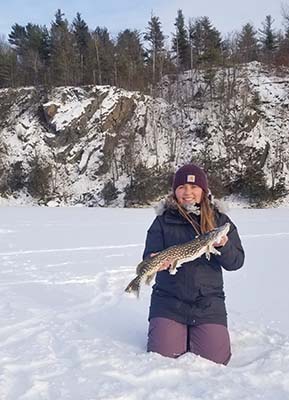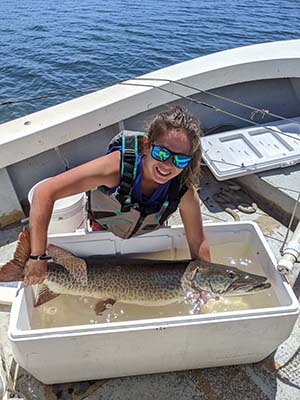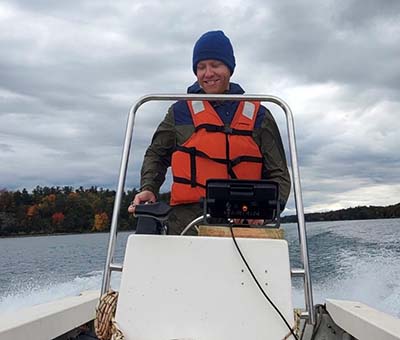Meet Our Graduate Students!

Katelyn Barhite (MS candidate)
Katelyn continues her work investigating the diet of Double-crested cormorant (DCC) by collection regurgitated pellets (undigested bones DCC regurgitate when you visit a nesting colony). She will be using a bone-key to reconstruct the fish diet from these leftover bits and pieces. We are also working with Dr. Hyatt Green at ESF to analyze the DNA retained in pellets to reconstruct diet with genetic tools. The two methods will be compared to see if they have agreement. DNA methods may save time and potentially could be more accurate in assessing DCC fish consumption.

Anna Conklyn (PhD candidate)
Anna applied for and received a Sussman Graduate Fellowship to support her research in summer 2022. She also applied for and received a Watershed Research Institute Grant for $11,200 to complete viral hemorrhagic sequencing as part of her doctoral studies. This funding will allow comparison of RNA sequences for identification of variants in her samples as an indicator of viral evolution. There is a concern that new variants may escape the immune system of sensitive fish species such as muskellunge that have been affected by VHS. In 2022, VHS has been detected in muskellunge adults found dead raising concern of another disease outbreak. Read more about Anna's Research.

Amanda Lemoine (MS candidate)

Thornton Ritz (PhD candidate)
Thornton has developed and is maintaining an impressive array of sensors for monitoring the rivers’ wetlands and physical features such as water temperature (every 2 hours) and dissolved oxygen and water levels. These precision measurements will be compared to fish data from live traps check daily as part of his studies. Many of the fish are the product of spring spawning runs and they are developing and emigrating to the main river as they grow. We also released 150,000 northern pike larvae in the sites and will be using the system to understand how they are doing. The data will inform how these environmental variables affect their success.
Read more about Thorton's Research.

Andrew Parnas (New MS candidate)
Fringing wetlands in coastal bays of the Great Lakes and St. Lawrence River are important habitat features for structing aquatic communities and biodiversity. Andrew will focus on the biocomplexity from aquatic plants to macroinvertebrates and fishes. We will test the importance of soft-stemmed bulrush as a keystone species, through its ability to withstand wave energy, grow in deeper water, and facilitate other species. A second interest is the effect of an invasive hybrid and narrow-leaved cattail that may be outcompeting bulrushes and other native emergent plants. Andrew’s study will focus on coastal wetlands at the head of Grindstone Island and their role in supporting aquatic communities.

Jackson Booth (New MS candidate)
Great Lakes and St. Lawrence River walleye are members of the perch family and are an important part of the fishery and ecosystem. Earlier research at TIBS (Thousand Islands Biological Station) helped assess genetic structure of population and we have worked with USFWS Cortland Office and DEC Region 6 in habitat improvements and walleye reproductive success. Jackson’s research will build on this and investigate a region-wide assessment of walleye spawning tributaries with a focus on restoration/creation of new spawning runs in the Thousand Islands Region.